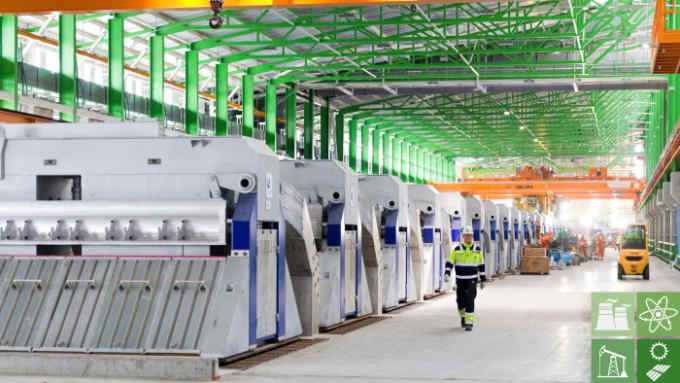Businesses push for greener buildings despite Trump rhetoric

Simply sign up to the Climate change myFT Digest -- delivered directly to your inbox.
Not long after President Donald Trump pulled the US out of the Paris climate change agreement, Christian Ulbrich, chief executive of JLL, found himself in a room full of leaders of US companies.
The head of the global real estate services group heard another chief executive ask whether anyone in the room supported the Paris accord. “He said it in a way that you felt embarrassed to say yes,” Mr Ulbrich recalls.
He and another corporate chief, both of European origin, sheepishly raised their hands.
German-born Mr Ulbrich may have been in a minority in that room, but in the world of real estate, the direction of travel is the opposite of Mr Trump’s. In 2016 — the most recent year for which figures are available — developers spent $406bn on energy efficiency in construction, about 9 per cent of worldwide construction and renovation spending, according to the Global Alliance for Buildings and Construction.
JLL, which has its headquarters in Chicago, now has 274 sustainability specialists among its staff, while its biggest rival, CBRE, has 220. JLL’s environmental work was unusual when it began about 20 years ago. Now, the group must compete with a variety of other consultancies to advise corporates on green buildings.
Despite the reluctance of some chief executives to oppose the Trump line, Mr Ulbrich says the impetus for change is coming from big corporates. “Originally we were pushing [sustainability],” he says, adding that as recently as five years ago, clients would often respond: “Fine, but I’m not going to pay for it.”
Now it is the other way round, he says. “The push is coming from corporates, who are making demands of developers.”
Since Mr Trump’s move, a series of companies have this year made pledges on mitigating their impact on the climate, ranging from cosmetics group L’Oréal to food retailer McDonald’s, which committed to steep reductions in emissions.
While much of the popular conversation about climate change focuses on transport, buildings present a significant opportunity for energy savings. According to UN figures, buildings are responsible for 36 per cent of global energy use by end users and 39 per cent of energy-related carbon dioxide emissions. That means companies promising a more climate-friendly approach must address their real estate portfolio.
In practice, this means more work for the likes of Mr Ulbrich. Real estate companies from Majid Al Futtaim, the Emirati shopping malls group, to its UK peer Hammerson have pledged, with JLL’s help, to become “net positive”, giving back more than they take from the environment in areas such as carbon consumption and water, through policies such as carbon offsetting, installing renewable power sources and water recycling.
But that goal is a long way off: Hammerson aims to achieve it by 2030, Majid Al Futtaim over the 21 years to 2040 — a period almost as long as the company has existed.
Meanwhile, “time is running out” to meet the Paris climate goals when it comes to buildings, according to the Global Alliance for Buildings and Construction. Energy intensity per square metre, a measure of how much energy is used, needs to improve 30 per cent by 2030, according to the body’s latest annual report. Yet many countries do not have mandatory building energy codes in place.
Tougher regulation may be part of the answer. Countries from Mexico to India are toughening energy efficiency requirements in their building codes, but Mr Ulbrich has doubts. He thinks that when it comes to commercial buildings, market demand will push developers the right way.
By contrast, he argues governments must step in when it comes to residential property, since ordinary homebuyers may lack the funds or information to improve energy efficiency. “On the residential side you need regulation — in commercial, it will happen anyway.”
Mr Ulbrich cites his native Germany as a country that has led the way on green buildings regulation, but warns it can go too far, particularly when combined with residential rent controls. “They have maybe gone over the top — building prices have moved up so significantly that sometimes it actually prevents the build. That results in people staying in very unsustainable buildings.”
Elsewhere, market forces appear to be having an effect. Studies have suggested that green building certifications, such as BREEAM in the UK or LEED in the US, which measure areas such as energy, waste and water, add to the market value of real estate assets.
Their popularity is growing: some 38 per cent of US office space in 30 key markets is now certified as “green” or “efficient” by LEED or rival Energy Star, up from 5 per cent 12 years ago, according to CBRE.
Sustainability has gained support in the US tech sector in particular, notes Mr Ulbrich, even as Mr Trump’s agenda has emboldened climate sceptics. “Some US companies are making great strides — others are of the view that there is no climate change.”
Key facts on world building energy use
- Buildings and construction together account for 36 per cent of global final energy use and 39 per cent of energy-related carbon dioxide emissions when upstream power generation is included
- Average global building energy intensity per square metre improved by 1.3 per cent last year but total floor area grew by 3 per cent
- Global average building energy use per person since 1990 has remained constant at 5 MWh per person per year
- Current investments in building energy efficiency are not on track to achieve “2DS” target aimed at limiting man-made global warming to no more than 2 degrees Celsius
- There has been a 45 per cent increase in building-related emissions since 1990
(Sources: UN Environment Global Status Report 2017 and Tracking Clean Energy Progress 2017 report published by the International Energy Agency)

Comments